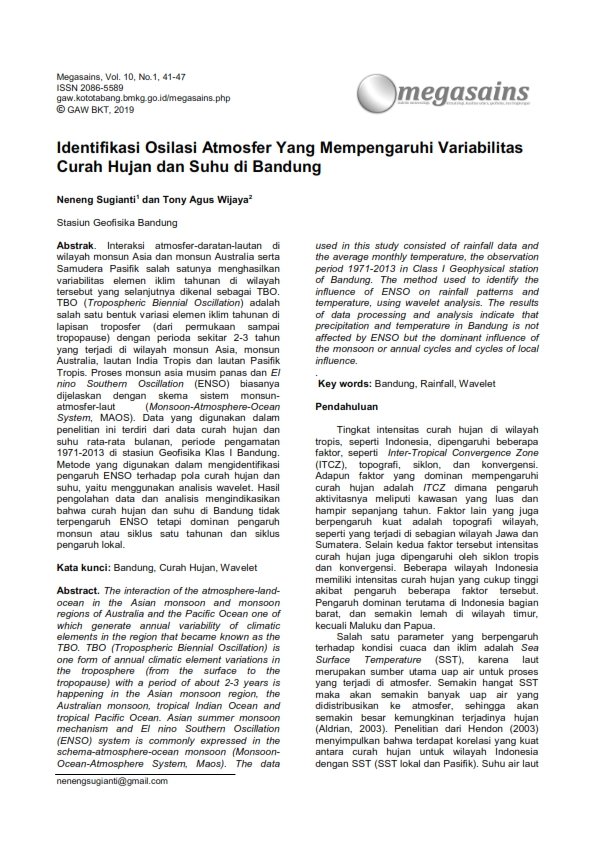Identifikasi Osilasi Atmosfer Yang Mempengaruhi Variabilitas Curah Hujan dan Suhu di Bandung
Isi Artikel Utama
Abstrak
Interaksi atmosfer-daratan-lautan di wilayah monsun Asia dan monsun Australia serta Samudera Pasifik salah satunya menghasilkan variabilitas elemen iklim tahunan di wilayah tersebut yang selanjutnya dikenal sebagai TBO. TBO (Tropospheric Biennial Oscillation) adalah salah satu bentuk variasi elemen iklim tahunan di lapisan troposfer (dari permukaan sampai tropopause) dengan perioda sekitar 2-3 tahun yang terjadi di wilayah monsun Asia, monsun Australia, lautan India Tropis dan lautan Pasifik Tropis. Proses monsun asia musim panas dan El nino Southern Oscillation (ENSO) biasanya dijelaskan dengan skema sistem monsun- atmosfer-laut (Monsoon-Atmosphere-Ocean System, MAOS). Data yang digunakan dalam penelitian ini terdiri dari data curah hujan dan suhu rata-rata bulanan, periode pengamatan 1971-2013 di stasiun Geofisika Klas I Bandung. Metode yang digunakan dalam mengidentifikasi pengaruh ENSO terhadap pola curah hujan dan suhu, yaitu menggunakan analisis wavelet. Hasil pengolahan data dan analisis mengindikasikan bahwa curah hujan dan suhu di Bandung tidak terpengaruh ENSO tetapi dominan pengaruh monsun atau siklus satu tahunan dan siklus pengaruh lokal.
Rincian Artikel

Artikel ini berlisensi Creative Commons Attribution-NonCommercial 4.0 International License.
Penulis bersedia memberikan hak atas publikasinya di bawah Lisensi Creative Commons Attribution-NonCommercial-NoDerivatives 4.0 International. Sehingga memungkinkan orang lain untuk berbagi karya dengan pengakuan atas karya penulis dan publikasi dalam jurnal ini.
Penulis dapat masuk ke dalam pengaturan kontrak tambahan yang terpisah untuk distribusi non-eksklusif versi karya jurnal yang diterbitkan (misalnya, mempostingnya ke repositori institusional atau mempublikasikannya dalam sebuah buku), dengan pengakuan publikasi awal dalam jurnal ini.
Penulis diizinkan dan didorong untuk mengirim karya mereka secara online (misalnya, dalam repositori institusi atau website mereka) sebelum dan selama proses pengajuan, karena dapat menyebabkan pertukaran produktif, serta sebelumnya dan kutipan yang lebih besar dari karya yang diterbitkan.

